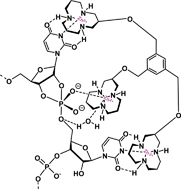Base moiety selectivity in cleavage of short oligoribonucleotides by di- and tri-nuclear Zn(II) complexes of azacrown-derived ligands†
Abstract
Cleavage of 6-mer oligoribonucleotides by the dinuclear Zn2+ complex of

* Corresponding authors
a
Department of Chemistry, University of Turku, Turku, Finland
E-mail:
paipoi@utu.fi
Fax: +358-2-3336700
Tel: +358-2-3336771
Cleavage of 6-mer oligoribonucleotides by the dinuclear Zn2+ complex of

 Please wait while we load your content...
Something went wrong. Try again?
Please wait while we load your content...
Something went wrong. Try again?
M. Laine, K. Ketomäki, P. Poijärvi-Virta and H. Lönnberg, Org. Biomol. Chem., 2009, 7, 2780 DOI: 10.1039/B904828F
To request permission to reproduce material from this article, please go to the Copyright Clearance Center request page.
If you are an author contributing to an RSC publication, you do not need to request permission provided correct acknowledgement is given.
If you are the author of this article, you do not need to request permission to reproduce figures and diagrams provided correct acknowledgement is given. If you want to reproduce the whole article in a third-party publication (excluding your thesis/dissertation for which permission is not required) please go to the Copyright Clearance Center request page.
Read more about how to correctly acknowledge RSC content.
 Fetching data from CrossRef.
Fetching data from CrossRef.
This may take some time to load.
Loading related content
